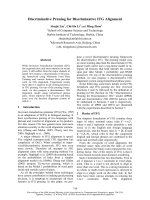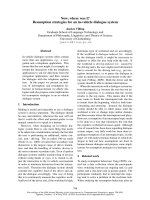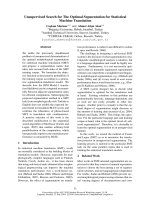Báo cáo khoa học: "Dialect Classification for online podcasts fusing Acoustic and Language based Structural and Semantic Information" pot
Bạn đang xem bản rút gọn của tài liệu. Xem và tải ngay bản đầy đủ của tài liệu tại đây (277.33 KB, 4 trang )
Proceedings of ACL-08: HLT, Short Papers (Companion Volume), pages 21–24,
Columbus, Ohio, USA, June 2008.
c
2008 Association for Computational Linguistics
Dialect Classification for online podcasts fusing Acoustic and Language
based Structural and Semantic Information
Rahul Chitturi, John. H.L. Hansen
1
Center for Robust Speech Systems(CRSS)
Erik Jonsson School of Engineering and Computer Science
University of Texas at Dallas
Richardson, Texas 75080, U.S.A
{rahul.ch@student, john.hansen@}utdallas.edu
Abstract
The variation in speech due to dialect is a factor
which significantly impacts speech system per-
formance. In this study, we investigate effective
methods of combining acoustic and language in-
formation to take advantage of (i) speaker based
acoustic traits as well as (ii) content based word
selection across the text sequence. For acoustics,
a GMM based system is employed and for text
based dialect classification, we proposed n-gram
language models combined with Latent Seman-
tic Analysis (LSA) based dialect classifiers. The
performance of the individual classifiers is es-
tablished for the three dialect family case (DC
rates vary from 69.1%-72.4%). The final com-
bined system achieved a DC accuracy of 79.5%
and significantly outperforms the baseline
acoustic classifier with a relative improvement
of 30%, confirming that an integrated dialect
classification system is effective for American,
British and Australian dialects.
1 Introduction
Automatic Dialect Classification has recently gained
substantial interest in the speech processing commu-
nity (Gray and Hansen, 2005; Hansen et al., 2004;
NIST LRE 2005). Dialect classification systems have
been employed to improve the performance for
Automatic Speech Recognition (ASR) by employing
dialect dependent acoustic and language models (Di-
akoloukas et al., 1997) and for Rich Indexing of Spo-
ken Document Retrieval Systems(Gray and Hansen
2005). (Huang and Hansen, 2005; 2006) focused on
identifying pronunciation differences for dialect clas-
sification. In this study, unsupervised MFCC based
GMM classifiers are employed for pronunciation
modeling. However, English dialects differ in many
ways other than pronunciation like Word Selection
and Grammar, which cannot be modeled using frame
based GMM acoustic information. For example,
1
This project was funded by AFRL under a subcontract to
RADC Inc. under FA8750-05-C-0029
word selection differences between UK and US dia-
lects such as - “lorry” vs. “truck”, “lift”, vs. “eleva-
tor”, etc. Australian English has its own lexical terms
such as tucker (food), outback (wilderness), etc (John
Laver, 1994). N-gram language models are employed
to address these problems. One additional factor in
which dialects differ is in Semantics. For example,
momentarily which means for a moments duration
(UK) vs. in a minute or any minute now (US). The
sentence “This flight will be leaving momentarily”
could represent different time duration in US vs. UK
dialects (John Laver, 1994). Latent Semantic Analy-
sis is a technique that can distinguish these differ-
ences (Landauer et al.,1998). LSA has been shown to
be effective for NLP based problems but has yet to be
applied for dialect classification. Therefore, we de-
velop an approach that uses a combination with n-
gram language modeling and LSA processing to
achieve effective language based dialect classifica-
tion accuracy. Sec 4 explains the baseline acoustic
classifier. Language classifiers are described in Sec 5
and the results which are presented in Sec 6 affirm
that combining various sources of information sig-
nificantly outperforms the traditional (or individual)
techniques used for dialect classification.
2 Online Podcast Database
The speech community has no formal corpus of audio
and text across dialects of common languages that
could address the problems discussed in Sec.1. It was
suggested in (Huang and Hansen, 2007) that it is
more probable to observe semantic differences in the
spontaneous text and speech rather than formal
newspapers or prepared speeches since they must
transcend dialects of a language (Hasegawa-Johnson
and Levinson, 2006; Antoine 1996). Therefore, we
collected a database from web based online podcasts
of interviews where people talk spontaneously. All
these are already been transcribed in order to separate
text and audio structure and to temporarily set aside
automatic speech recognition (ASR) error. These
podcasts are not transcribed with an exact word to
21
word match but they match the audio to an extent that
include what the speakers intended to say. The lan-
guage and Acoustic statistics of this database are de-
scribed in Sec 2.1, and 2.2.
2.1 Language Statistics
Huang and Hansen observed that the best dialect
classification accuracy for N-gram classification re-
quires at least 300 text words to obtain reasonable
performance (Huang and Hansen, 2007). So, these
interviews are segmented into blocks of text with an
average text of 300 words. Table 1 summarizes the
text material for three family-tree branches of Eng-
lish, containing 474k words and 1325 documents.
No. of Documents
Dialect
No.of
words
Train
Test
US English
200k
383
158
UK English
154k
288
122
AU English
120k
233
141
Table 1: Language Statistics
2.2 Acoustic Statistics
We note that the data collected from online podcasts
is not well structured. The audio data is segmented
into smaller audio segment files since we are inter-
ested in 300 word blocks. Since the collection of dia-
lect podcasts are collected from a wide range of
online sources, we assume that channel effects and
recording conditions are normalized across these
three dialects. We also note that there is no speaker
overlap between the test and train data. Therefore,
there are no additional acoustic clues other than dia-
lect. Table 2 summarizes the acoustic content of the
corpus with 231 speakers and 13.5 hrs of audio.
No. of Hours
Dialect
Males
Females
Train
Test
US English
48
37
3.2
1.7
UK English
40
32
2.3
1
AU English
36
38
3.3
2
Table 2: Acoustic Statistics
3 System Architecture
The system architecture is shown in Fig 1, which
consists of two main system phases for acoustic and
language classifiers. MFCC based classifiers are used
for acoustic modeling, while for language modeling,
we use a combination of n-gram language modes and
LSA classifiers. In the final phase, we combine the
acoustic and language classifiers into our final dialect
classifier. To construct the overall system, we first
train the individual classifiers, and then set the
weights of the hybrid classifiers using a greedy strat-
egy to form the overall decision.
4 Baseline Acoustic Dialect Classification
GMM based acoustic classification is a popular
method for text-independent dialect classification
(Huang and Hansen, 2006) and therefore it is used as
a baseline for our system. Fig. 2 shows the block dia-
gram of the baseline gender-independent MFCC
based GMM training system with 600 mixtures for
each dialect. While testing, the incoming audio is
classified as a particular dialect based on the maxi-
mum posterior probability measure over all the Gaus-
sian Mixture Models. Mixture and frame selection
based techniques as well as SVM-GMM hybrid tech-
niques have been considered for dialect classification
(Chitturi and Hansen, 2007). In order to assess the
improvement by leveraging audio and text, we did
not include these audio classification improvements
in this study.
5 Dialect Classification using Language
As shown in Fig 1, the language based dialect classi-
fication module has two distinct classifiers. We de-
scribe in detail the n-gram and LSA based classifiers
in the sections 5.1 and 5.2
5.1 N-gram based dialect classification
It is assumed that the text document is composed of
many sentences. Each sentence can be regarded as a
sequence of words W. The probability of generating
W is given by . Assum-
ing the probability depends on the previous n words
is
where m is
the number of words in W, w
i
is the word and D
{UK, US, AU) is the dialect specific language model.
The n-gram probabilities are calculated from occur-
rence counting. The final classification decision is
given by C= , where ϕ is a set of
sentences in a document and D {UK, US, AU}. In this
study, we use the derivative measure of the cross en-
tropy known as the test set perplexity for dialect clas-
sification. If the word sequence is sufficiently long,
the cross entropy of the word sequence W is ap-
proximated as . The per-
plexity of the test word sequence W as it relates to
the language model D is
.The perplexity of the test word se-
quence is the generalization capability of the lan-
guage model. The smaller the perplexity, the better
22
the language model generalizes to the test word se-
quence. The final classification decision is,
C= , where is the set of
sentences in a document, D {UK, US, AU}.
Figure 1: Proposed architecture
Figure 2: Baseline GMM based dialect classification
5.2 Latent Semantic Analysis for Dialect ID
One approach used to address topic classification
problems has been latent semantic analysis (LSA),
which was first explored for document indexing in
(Deerwester et al., 1990). This addresses the issues of
synonymy - many ways to refer to the same idea and
polysemy – words having more than one distinct
meaning. These two issues present problems for dia-
lect classification as two conversations about a topic
need not contain the same words and conversely two
conversations about different topics may contain the
same words but with different intended meanings. In
order to find a different feature space which avoids
these problems, singular value decomposition (SVD)
is performed to derive orthogonal vector representa-
tions of the documents. SVD uses eigen-analysis to
derive linearly independent directions of the original
term by document matrix A whose columns corre-
spond to the number of dialects, while the rows cor-
respond to the words/terms in the entire text database.
SVD decomposes this original term document matrix
A, into three other matrices: A=U*S*V
T
, where the
columns of U are the eigenvectors of AA
T
(left ei-
genvectors), S is a diagonal matrix, whose diagonal
elements are the singular values of A, and the col-
umns of V are the eigenvectors of A
T
A(called right
eigenvectors). The new dialect vector coordinates in
this reduced 3 dimensional space are the rows of V.
The coordinates of the test utterance is given by
q1=q
T
*U*S
-1
. The test utterance is then classified as
a particular dialect based on the scores, given by the
cosine similarity measure as
, where d
i
is one of the three dialects.
6 Results and Discussion
All evaluations presented in this section were con-
ducted on the online podcast database described in
the section 2. The first row of Table 3 shows the per-
formance of the N-gram LM based dialect classifica-
tion (69.1% avg. performance). From this we observe
that this approach is good for US and UK, but not as
effective for AU family dialect classification, with
AU being confused with UK. The performance of the
LSA based dialect classification is shown in the sec-
ond row of Table 3. This classifier is consistent over
all the dialects with better performance than the N-
gram LM approach. There is more semantic similar-
ity of US with AU than UK (24% vs 5% - false posi-
tives), while UK has a balanced semantic error with
US and AU. This implies that there is more semantic
information in these dialects than text sequence struc-
ture.
Next, the N-gram and the LSA classifiers are com-
bined using optimal weights based on a greedy ap-
proach. Fig. 3 shows the performance of this hybrid
classifier with respect to the weights of the individual
classifiers (N-gram vs LSA: 0all N-gram, 500.5
N-gram and 0.5 LSA, 100 all LSA). After setting
the optimal weights 0.18 to LSA and 0.82 to N-gram
classifier, the hybrid classifier is seen to be consistent
and better than the individual classifiers (Table 3:
row 3 vs row2/row1). Performance of the hybrid
classifier is not as good as the LSA classifier for AU
classification, but significantly better for classifica-
tion of US and UK. The hybrid classifier is better in
all cases when compared to the N-gram classifier,
with an overall average improvement of 7.3% abso-
lute. The fourth row in Table 3 shows the perform-
ance of acoustic based dialect classification which is
as good as the language based dialect classification,
but it is noted that performance is poor for UK classi-
fication. It is expected that the type of errors made by
text (word selection), semantics and acoustic space
MFCC based
Acoustic
GMM Classifier
Text
Audio
N-Gram
Classifier
LSA
Classifier
Language
Classifier
Online
Podcasts
Final Hybrid Acoustic &
Language Classifier
GMM1
Choose
Maximum
Likelihood
GMM2
0
0
0
0
Silence
Remover
Feature
Extraction
Input
Audio
GMM n
23
will have differences and therefore we combine these
acoustical and language classifiers as shown in Fig1.
The overall performance of the proposed approach,
combining the acoustic and language information, is
better than the individual classifiers (Row 3 and Row
4 vs. Row 5 of Table 3). Even though the perform-
ance for US is reduced from 87.2% to 86.38%, the
classification of UK is improved significantly from
54% to 74%. This shows that this approach is more
consistent with accuracy that outperforms traditional
acoustic classifiers with a relative improvement of
30%. With respect to a language only classifier, this
hybrid classifier is better in all the cases.
7 Conclusions
In this study, we have developed a dialect classifica-
tion (DC) algorithm that addresses family branch DC
for English (US, UK, AU), by combining GMM
based acoustic, and text based N-gram LM and LSA
language information. In this paper, we employed
LSA in combination with N-gram language models
and GMM acoustic models to improve DC accuracy.
The performance of the individual classifiers were
shown to vary from 69.1%-72.4%. The final com-
bined system achieves a DC accuracy of 79.5% and
significantly outperformed the baseline acoustic clas-
sifier with a relative improvement of 30%, confirm-
ing that an integrated dialect classification system
employing GMM based acoustic and N-gram LM,
LSA based language information is effective for dia-
lect classification.
Figure 3: Language classifier
References
Diakoloukas, V.; Neumeyer, L.; Kaja, J.; 1997. “Develop-
ment of dialect-specific speech recognizers using adap-
tation methods” IEEE- ICASSP
John Laver; 1994. “Principles of Phonetics”. Cambridge
University Press, Cambridge, UK.
F
Figure 4: Acoustic + Language classifier
Accuracy→
Methods↓
US
UK
AU
Overall
N-Gram LM
Classifier
75.2%
71.2%
60.7%
69.1%
Latent Semantic
(LSA) Classifier
70.2%
68.5%
78.7%
72.47%
N-Gram+ LSA
(Based on Text)
79.3%
74.6%
75.4%
76.4%
Acoustic GMM
Classifier
87.2%
54.0%
73.3%
71.6%
Acoustic GMM
+ N-gram+ LSA
86.4%
74.6%
77.0%
79.5%
Table 3: Performance of classifiers on Dialect-ID
Gray, S.; Hansen, J.H.L; 2005. “An integrated approach to
the detection and classification of /dialects for a spoken
document retrieval system” IEEE- ASRU
Huang R; Hansen J.H.L.; 2005. "Dialect/Accent Classifica-
tion via Boosted Word Modeling," IEEE-ICASSP
Landauer,T.K., Foltz,P.W., & Laham,D; 1998. " Introduc-
tion to Latent Semantic Analysis " Discourse Processes,
25, 259-284.
Huang R; Hansen J.H.L.2007 "Dialect Classification on
Printed Text using Perplexity Measure and Conditional
Random Fields," IEEE- ICASSP
Hasegawa-Johnson M, Levinson S.E, 2006 "Extraction of
pragmatic and semantic salience from spontaneous
spoken English " Speech Comm. Vol. 48(3-4)
Antoine, J Y 1996 " Spontaneous speech and natural lan-
guage processing. ALPES: a robust semantic-led parser
" ICSLP
Deerwester.S. et al.1990." Indexing by latent semantic
anlysis " Journal of American Society of Information
Science, 391–407.
Chitturi. R, Hansen J.H.L, 2007." Multi stream based Dia-
lect classification using SVM-GMM hybrids" IEEE-
ASRU
Huang. R, Hansen J.L.H.; 2006. “Gaussian Mixture Selec-
tion and Data Selection for Unsupervised Spanish Dia-
lect Classification” ICSLP
Hansen J.H.L., Yapanel.U, Huang.R., Ikeno.A ; 2004.
“Dialect Anal'ysis and Modeling for Automatic Classi-
fication” ICSLP
NIST- LRE 2005,” Language Recognition Evaluation”
24









